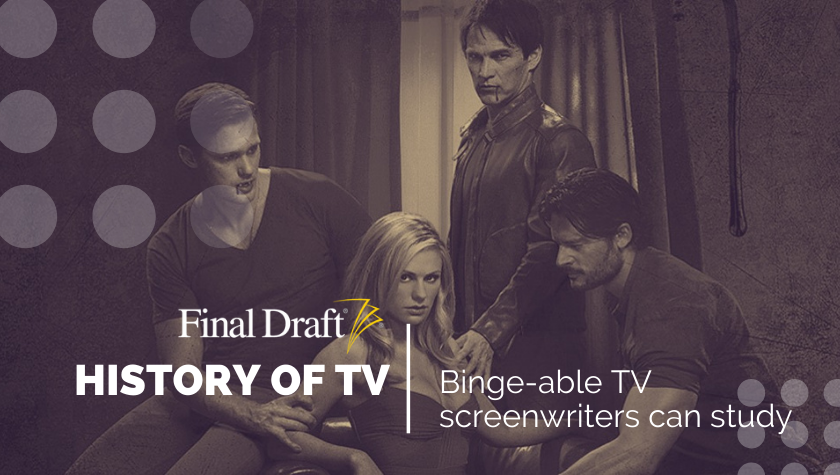History of TV: ‘Buffy the Vampire Slayer’ and High Stakes Teenage Angst
October 29, 2020
The first time I watched Buffy the Vampire Slayer was at a Halloween party in high school. Appropriate — and I was appropriately terrified. Vampires?! Werewolves?! A Hellmouth under the city just waiting to unleash another Monster of the Week?! Nuh-uh, not for me…
Until I watched another episode, because damn those vamps were hot. His name was Angel (a prime piece of character-naming perfection) and his storyline with The Chosen One could put Romeo & Juliet to shame... Until along came the devilishly charming Spike (played by James Marsters). And the werewolf? Yeah, he had a heart of gold and was in love with the wallflower witch. And together, these offbeat outcasts formed the Scooby Gang and had each other to face the terrors of high school with (demons not withstanding).
But what does that all mean for a screenwriter? Vampires have been “done” time and again. Why was Buffy so special? Oh, let me count the ways…
Monsters as metaphors
It’s no coincidence that Sunnydale High (the whole town, in fact) sat right smack dab on top of the show’s mythical Hellmouth. High school IS hell for most people. So, while slayer Buffy Summers (played by the infinitely lovable Sarah Michelle Gellar) and her friends fought the forces of darkness, they also had to reconcile that life with the very real trials that high school presents. The demons were often manifestations of a situation or emotion a character was going through, and therefore became even more intrinsically linked to the show’s theme and structure.
One of the many poignant moments of the series occurred when Buffy lost her virginity to Angel (arguably David Boreanaz’s breakout role) in season two’s “Innocence,” only to wake up the next morning and find that he’d changed into Angelus — the most wicked Vampire alive, so to speak. This one plot point sent the show’s storyline off in an entirely new direction, changed up a major character, and managed to speak to the show's target audience (namely, teenage girls) on an intimate level. What does happen to someone when they discover that the person they gave their heart to is happy to toss it away now that they got what they came for? While Angel eventually regains his soul, turns out he and Buffy can never ever be together again, and no magic can save them, thereby setting up a beautiful agony for our lead lovers.
A strong story engine
This is going to come up for pretty much every show we cover in this column, because it’s so crucial to keeping a show alive season after season. While some shows survive based on self-reinvention (American Horror Story, I’m looking at you!), others persevere because it’s just plain relatable. And Buffy had it all: underdogs prevailing, the perils of high school, and love stories.
It was a glorious mix of horror, comedy and teenage drama. An angle, and a target audience, that hadn’t really been examined up until Buffy launched on the fledgling WB network in 1997. While the show revolved around Buffy, it didn’t entirely rely on her, either. The strong supporting characters all had their own demons to tackle, making it appealing to a wider audience. So what had started as a low-budget gamble went on for seven seasons. It did pull a fast one, killing off the lead by having Buffy sacrifice herself in the season five finale, coincidently on episode 100. But true to form, it had one more surprise up its sleeve: the show came back, as did Buffy Summers, even if she was a little less chipper about being back among the living. Which leads us to: structure.
Structuring a cult classic
The slow burn. Buffy was one of those '90s shows that forged the way for the long story arc, especially in genre television. It went beyond the monster of the week to set up the "big bad" throughout the season as the final confrontation for the finale. It seems “like, duh!” now to screenwriters, but back in Buffy’s heyday, it wasn’t. This is partially thanks to writer-director Joss Whedon’s comic book influence.
The show was not only one of the first to really utilize the season arc to its full advantage, Buffy also left us with some remarkable forays into experimental structure (for its time). They say the more white space on the page, the better. I’d love to see the script for Buffy’s near-silent episode, “Hush” (season four, episode 10). One of the most innovative of the series, it features the creepy “gentlemen” who steal everyone’s voices, thus making room for incredible nuanced acting to occur as the majority of the episode rolled along dialogue-less.
Then there was the musical episode. Yet another demon stops by Sunnydale, but this time, their spell provokes characters to break into spontaneous song and dance... causing major unintended (by the character) revelations to happen. It’s just one you have to see to believe: “Once More With Feeling” (season six, episode seven).
That dialogue, though
The writer’s voice. We hear this a lot as screenwriters, that we need to show our voice in our writing. It’s not easy. So when it’s done well, it positively sparkles. Buffy’s voice is what made the show so remarkable. Aside from Whedon’s signature wit, writers such as Jane Espenson (Once Upon a Time), Marti Noxon (UnREAL), Drew Goddard (The Martian), and David Greenwalt (Grimm) crafted dialogue that jumped off the page and just felt so…real. For a world infested with mythical creatures. They created an authentic language, never falling into the trap of “adults” writing “teen slang”. This is one of Buffy’s best takeaways for screenwriters: how can you write dialogue in your script that feels “of the now” while still holding up over two decades later?
In retrospect
Buffy bravely faced the real pathos of life, examining the responsibility of power and inevitability of death, right alongside the monsters that made the show famous. It blended action with biting wit. It also broke down barriers. Alyson Hannigan’s Willow was one of the first LGBTQ characters to consummate a lesbian love scene on network TV. And the slayer herself broke the mold. Love him or hate him, Joss Whedon is a great writer. He crafted a world that will forever be beloved, as well as debated and dissected. He turned the horror movie trope of pretty blonde girls getting axed (literally) on its head. Buffy taught us all how to slay; ultimately putting the whole slayer patriarchy down by defying her own prophecy and sharing the power. She lead the way for them all: Sydney Bristow, Bo Dennis, Echo, Jessica Jones. There's a reason she's a classic.
“So here’s the part where you make a choice. What if you could have that power, now? In every generation, one slayer is born, because a bunch of men who died thousands of years ago made up that rule. They were powerful men. This woman is more powerful than all of them combined. So I say we change the rule. I say my power should be our power. Tomorrow, Willow will use the essence of the scythe to change our destiny. From now on, every girl in the world who might be a slayer, will be a slayer. Every girl who could have the power, will have the power, can stand up, will stand up. Slayers every one of us. Make your choice. Are you ready to be strong?” - Buffy
Written by: Karin Maxey
After seeing her first big screen movie 007: License to Kill at age six, Karin naturally became obsessed with writing action-infused stories. The next time she’d see Benicio del Toro was in person, at the 68th Cannes Film Festival—he was there for the Sicario red carpet, she was there for her first produced short film in the basement of the Palais…same-same. In between, Karin earned a Creative Writing Degree and landed management at Echo Lake Entertainment. Her scripts have been a Big Break Top 3 finalist, HollyShorts Film Fest Official Selection, and a multi-Screencraft competitions semi-finalist. Karin is also a screenplay editor who delights in the process of polishing writers' work for submission. You can find her at www.writergirlkarin.com.- Topics:
- Discussing TV & Film




